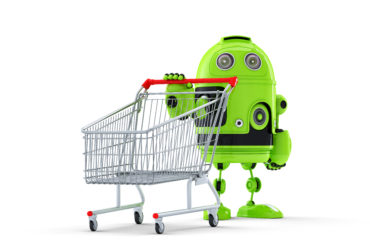Ecommerce businesses of all types are thriving. Some business and revenue models are more in practice than the other. But each model has advantages and disadvantages of their own. It’s easy to get caught up in a tide of new e-commerce trends, you need to find what suits the goals of your business. Many E-commerce owners are not aware of the different business models that can help them bloom their business. Knowing the fundamentals before choosing a model for your business is essential. Here’s all that you need to know about the 7 eCommerce models to impacts business growth.
4 traditional Types of eCommerce
While there are different eCommerce business models, let us understand the 4 traditional types of eCommerce :
B2B


In simple words, B2B means Business to business. It encompasses all companies that gear their products and services to other companies. B2B refers to the sale of products or services that are exchanged through an online platform between companies. This describes the business transacted between companies and not individuals. Because of the large nature of businesses, the volume of products and services is much higher, the shipping requirements are much more complicated. The complexity of B2B businesses requires them to deal with higher and complex tax impediments. But nevertheless, they are a vital part of most industry’s supply chain.
Example: The manufacturer of an automobile derives many products likes tires, hoses, batteries, etc. to make the final product. When you invest in a car, you’re purchasing parts created by hundreds of other businesses from all over the world.
B2C


B2c is a term used to describe an e-commerce transaction that takes place between a business and its end-user. In this type of e-commerce, the consumer directly consumes the product or service provided by a business entity. It sells to customers directly. The major benefit of B2c is the global reach that it has. The size of a business does not limit the reach of selling operations. Additionally, they have no physical overheads, trackable markets, more data to profile customers.
Example: Most food restaurants fall under this type. Another example would be Spotify.
C2C


This E-commerce model refers to the trade between two customers, not businesses. C2C is gaining more importance. The interaction between two parties is presupposed by a third party. Sellers can find buyers through various internet resources by paying a small fee or commission. Due to the lack of involvement of middlemen, the prices of commodities are reduced, this proves to be a major advantage for customers. On the other hand, vendors are benefited from direct sales causing high profitability.
Example: Amazon, Flipkart.
C2B


In contrast with the other business models, the C2B (customer-to-business) model allows businesses to extract businesses from customers. In this model, businesses profit by the willingness of consumer’s contributions. This could involve consumers contributing through the co-creation of ideas, product/service concepts, and solutions as well.
Example: Food companies asking food bloggers to include a specific product in their recipes, and review it for their audiences.
E-Commerce Business Model


The e-commerce business model in the conceptual structure of the traditional B2B, B2C, C2C, C2B business strategies.
Based on the inventory management and sourcing of products, e-commerce business models are further classified into:
Dropshipping
Dropshipping is the simplest form of e-commerce, as it frees you from managing inventory, warehouse stock, or dealing with packaging. This focusses on a fulfillment model that allows you to buy products individually from a wholesaler directly to your customer. It eliminates the cost that you would be born if you invested in a large amount of inventory. Instead of doing that, your simple partner up with a drop shipping supplier and list their merchandise available for sale. Once you receive an order, you take it forward to the supplier for fulfillment. The supplier then ships the order from the warehouse directly to your customers.
Wholesaling or Warehousing
Wholesaling or warehousing method refers to the purchase of goods in bulk from manufacturers or distributors and reselling them through online platforms to other businesses. This model requires a lot of investment initially as you need to manage inventory and stock, track customer order and shipping information, and investing in warehouse space itself.
Types of wholesalers are: –
- Merchant wholesalers
- Retail wholesalers
- Limited-service wholesalers
- Brokers and agents
- Branches and mini offices
White-labelling
White labeling is quite similar. You choose a product that is already being sold by another company, The difference is that offers white-label options, the liberty to design your package and label. White labeling is quite common in the beauty and wellness industries. The only drawback with white labeling is demand. You’re stuck with whatever you order.
Ecommerce revenue model


The most important thing for building e-commerce is getting revenue. Let’s take a look at the key monetizing ways:
Direct sales
The direct sales model is the most commonly used revenue earning model used by most e-commerce companies. Moreover, this model involves setting up a store on an online platform or a self-owned website and shipping goods as and when the customer pays for the product.
Freemium model
Freemium model in an internet-based revenue model. Here, basic services are provided free of charge but charges are levied on premium features. Freemium is a blend of free and premium, and strategy is quite popular. LinkedIn, Tinder, YouTube, etc. are market leaders as they use a freemium model to increase their user-base.
Subscription model
This revenue model is one of the most popular and successful models. Thus, companies that chose this model rely on a subscription model that delivers products to customers at regularly scheduled intervals. Subscription companies tend to have a more reliable income stream and can very easily incentivize customers.

Credit model
Hence, this method is still finding it’s way to different parts of the world. Alongside, the credit revenue model, a customer can buy first and pay later. The income generated done is in the form of profits +interest.
Now that all of the e-commerce business, product options, platform, and business classification prevail, one can go ahead and get started. No matter what business model of the 7 eCommerce models you choose, chances are that you might need funding to scale your business.
eCommerce business is never complete without an overall shipping solution. Hence, Dash101 – A business cum shipping partner. The logistics aggregator delivers over 27000+ pin codes across the country along with 8 courier integrations and channel integrations. Alongside reduced RTO and seamless shipping experience, Dash101 looks after everything moves out of the warehouse and delivers to the customer.






Leave a Review